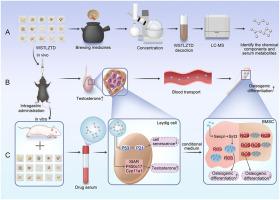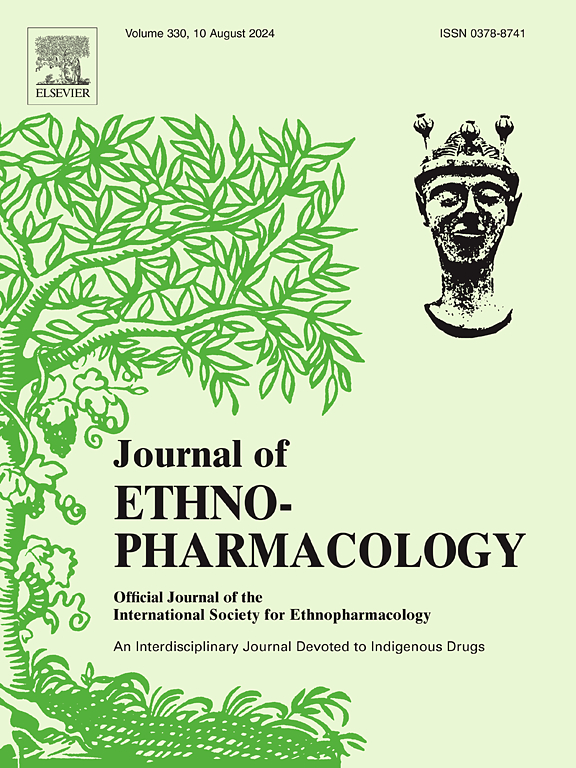温神通络汤通过促进睾酮生成抑制老年性骨质疏松症模型小鼠的骨质流失。
IF 4.8
2区 医学
Q1 CHEMISTRY, MEDICINAL
引用次数: 0
摘要
民族药理学意义:温神通络汤(WSTLZTD)是一种传统中药方剂,其治疗老年性骨质疏松症(SOP)的疗效已被临床研究证实。然而,WSTLZTD 治疗老年性骨质疏松症的内在机制尚不清楚:本研究旨在阐明温神通络汤(WSTLZTD)对老年性骨质疏松症(SOP)的独特作用及其内在机制:用不同剂量的WSTLZTD治疗SAMP6小鼠作为SOP模型。通过显微 CT、HE、OCN 免疫组化染色和血清 Trap 水平评估骨质流失。代谢组学研究血清代谢物。利用 ELISA、qPCR 和免疫荧光法测量小鼠睾丸中的睾酮水平。利用 ROS 生成、NAD+/NADH 比率和 WB 研究睾酮对 BMSCs 线粒体能量代谢的影响。细胞衰老是通过β-半乳糖苷酶染色和WB检测的。利用ALP、ARS、ROS染色、NAD+/NADH和WB研究了TM3细胞条件培养基(CM)对线粒体能量代谢和BMSCs成骨的影响:结果:WSTLZTD能有效逆转SOP模型小鼠的骨质流失,改善骨微结构,增加BMD、BV/TV、Tb.n、Tb.Th和,降低Tb.Sp。WSTLZTD 可以增加 OCN 表达,降低 Trap 水平。网络药理学数据表明,WSTLZTD 可调节类固醇激素的产生、细胞衰老和炎症。代谢组学数据表明,WSTLZTD 能增加睾酮的产生或代谢相关代谢物的产生。WSTLZTD 增加了睾酮的产生和参与睾酮合成的基因的 mRNA 表达。睾酮抑制了衰老 BMSCs 成骨分化和线粒体能量代谢的下降。WSTLZTD 逆转了衰老 TM3 中睾酮生成的减少。WSTLZTD处理的TM3细胞产生的CM促进了BMSCs的成骨分化和线粒体能量代谢:WSTLZTD可通过增加睾酮的产生促进线粒体能量代谢和衰老BMSCs的成骨分化,从而发挥其抗SOP作用。本文章由计算机程序翻译,如有差异,请以英文原文为准。

Wen-Shen-Tong-Luo-Zhi-Tong-Decoction inhibits bone loss in senile osteoporosis model mice by promoting testosterone production
Ethnopharmacological relevance
Wen-Shen-Tong-Luo-Zhi-Tong-Decoction (WSTLZTD) is a traditional Chinese medicine formula, and its effectiveness in the treatment of senile osteoporosis(SOP) has been confirmed by clinical studies. However, the underlying mechanism of WSTLZTD in SOP is unclear.
Aim of the study
This study aimed to clarify the unique effects of Wen-Shen-Tong-Luo-Zhi-Tong-Decoction(WSTLZTD) on senile osteoporosis(SOP) and its underlying mechanisms.
Materials and methods
SAMP6 mice were treated with varying doses of WSTLZTD as the SOP model. Bone loss was evaluated by micro-CT, HE, OCN immunohistochemistry staining, and serum Trap level. Metabolomics studies serum metabolites. ELISA, qPCR, and immunofluorescence were utilized to measure testosterone levels in mouse testis. The effect of testosterone on the mitochondrial energy metabolism of BMSCs was investigated using ROS generation, NAD+/NADH ratio, and WB. Cell senescence was examined by β-galactosidase staining and WB. The effect of TM3 cell conditioned media (CM) on mitochondrial energy metabolism and BMSCs osteogenesis were studied using ALP, ARS, ROS staining, the NAD+/NADH, and WB.
Results
WSTLZTD effectively reversed bone loss in SOP model mice, resulting in better bone microstructure, increased BMD, BV/TV, Tb.n, Tb.Th and, and decreased Tb.Sp. WSTLZTD can increase OCN expression and decrease Trap levels. Network pharmacology data suggest that WSTLZTD regulates steroid hormone production, cellular senescence, inflammation. Metabolomic data indicate that WSTLZTD increases testosterone production or metabolism-related metabolites. WSTLZTD enhanced testosterone production and the mRNA expression of genes involved in testosterone synthesis. Testosterone inhibited the decline in osteogenic differentiation and mitochondrial energy metabolism of senescent BMSCs. The decreased testosterone production in senescent TM3 is reversed by WSTLZTD. CM derived from WSTLZTD-treated TM3 cells promoted osteogenic differentiation and mitochondrial energy metabolism of BMSCs.
Conclusions
By increasing testosterone production, WSTLZTD may promote mitochondrial energy metabolism and osteogenic differentiation of senescent BMSCs, thereby exerting its anti-SOP effect.
求助全文
通过发布文献求助,成功后即可免费获取论文全文。
去求助
来源期刊

Journal of ethnopharmacology
医学-全科医学与补充医学
CiteScore
10.30
自引率
5.60%
发文量
967
审稿时长
77 days
期刊介绍:
The Journal of Ethnopharmacology is dedicated to the exchange of information and understandings about people''s use of plants, fungi, animals, microorganisms and minerals and their biological and pharmacological effects based on the principles established through international conventions. Early people confronted with illness and disease, discovered a wealth of useful therapeutic agents in the plant and animal kingdoms. The empirical knowledge of these medicinal substances and their toxic potential was passed on by oral tradition and sometimes recorded in herbals and other texts on materia medica. Many valuable drugs of today (e.g., atropine, ephedrine, tubocurarine, digoxin, reserpine) came into use through the study of indigenous remedies. Chemists continue to use plant-derived drugs (e.g., morphine, taxol, physostigmine, quinidine, emetine) as prototypes in their attempts to develop more effective and less toxic medicinals.
 求助内容:
求助内容: 应助结果提醒方式:
应助结果提醒方式:


